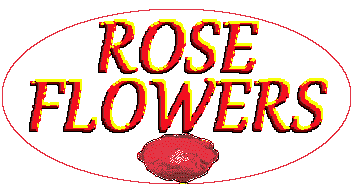
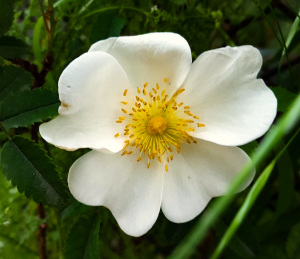
The blossoms of wild, native roses are similar to our Standard Blossom in that they possess five bright petals, as shown at the right on one of the 140 or so naturally occurring rose species (about 33 in North America).
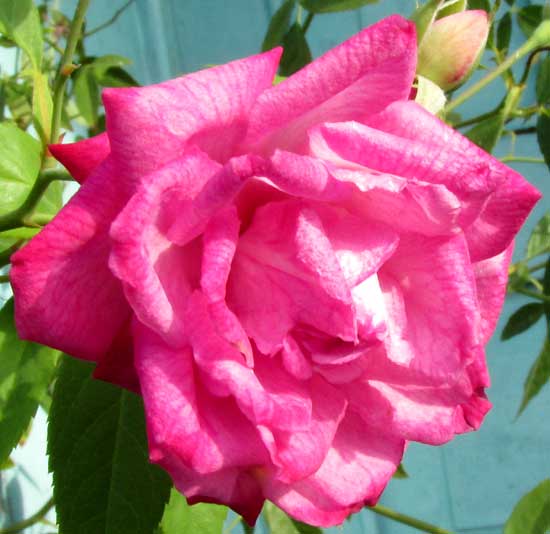
However, as you can see on the garden-growing rose blossom at the left, cultivated roses normally bear many more than five petals. That's because nearly all the roses in average backyards have been hybridized and otherwise had their genes changed by humans, to produce extra petals and be more colorful. The rose in the picture seems to be one of many cultivars based on the Climbing Prairie Rose, Rosa setigera, a robust native of eastern North America, much used as a hybrid parent.
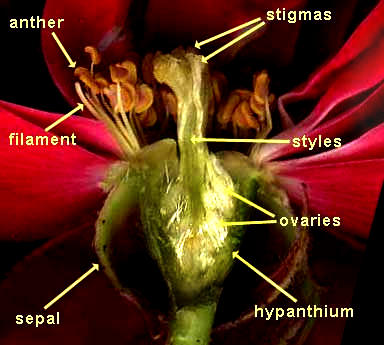
If you break open a garden rose to see the various parts, you'll find something like what's shown at the right. Pollen from other flowers is deposited on the stigmas. The male sex germ migrates inside a root-like pollen tube from the pollen grain, down through the style the stigma was attached to, to an ovary. Inside each ovary resides an ovule, which will mature into a seed. The flower's male parts, the stamens, consist of many pollen-producing anthers atop slender, stem-like filaments.
All these flower parts appear on our Standard Blossom, but rose flowers arrange them differently. Besides garden roses bearing many more petals than the natural five, rose blossoms produce more numerous pistils instead of just one, each consisting of stigma, style and ovary. And here's the really big difference: There's a hypanthium.
A relative handful of plant families produce flowers with hypanthiums, so when you see a flower with one, you've noted an important diagnostic feature to help in the plant's identification. For backyard naturalists in the Temperate Zone, the Rose Family is the main one producing hypanthiums, though also you can see them in the Bean and Lily Families, and a few places elsewhere.
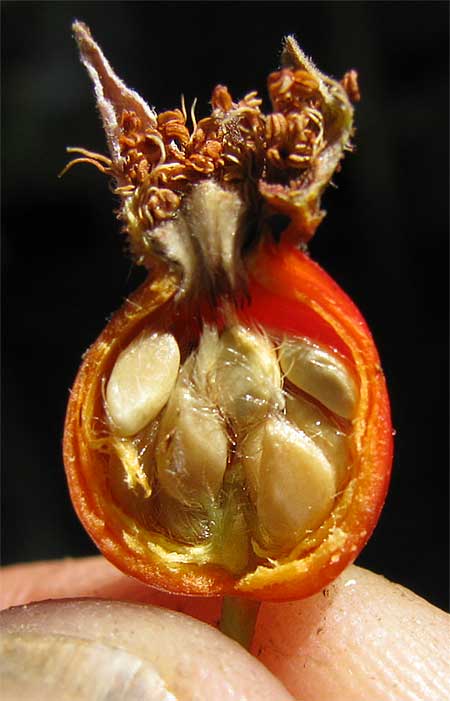
On roses, the hypanthium forms a leathery covering of what normally is considered the fruit, known as a "hip," a term made famous among people who drink herbal rose-hip tea. At the left, that's a broken-open rose hip, from the Clustered Wild Rose, Rosa pisocarpa, of western North America.
Botanically, the rose hip is not a fruit. The whole hip is a hypanthium, also known as a "pseudo fruit." In our picture, the actual fruits are the white, seed-like items surrounded by the red hypanthium. They are achene-type fruits, meaning that they are dry, one-seeded fruits which do not split open when mature. In the picture, the hypanthium/hip is topped with the flower's shriveling, dried-out calyx lobes, and clusters of old, dry stamens.

But, back to the many petals a garden rose has. How did horticulturists get wild, 5-petaled rose flowers to produce so many extra petals?
It happens that the genetic information that produces stamens is closely associated with that which produces petals. A confirmation of that is that sometimes in rose flowers you find a stamen with certain features of a petal, or a petal with certain features of a stamen. At the right you see just such a thing. There a cluster of stamens removed from an ordinary ornamental rose blossom, has one of the stamens' anthers becoming "petaloid" on one side. In this same blossom certain petals bore what appeared to be the beginnings of a stamen filament along the petals' edges!